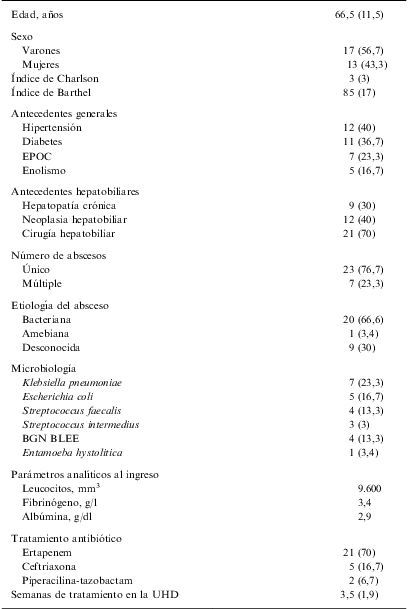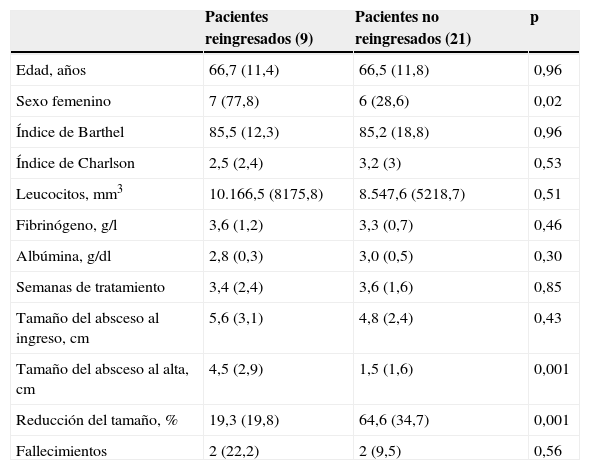Existen pocos datos en la bibliografía sobre el tratamiento antibiótico intravenoso de abscesos hepáticos en unidades de hospitalización a domicilio (UHD). Nuestros objetivos fueron analizar las características de los pacientes con abscesos hepáticos ingresados en nuestra UHD, la eficacia y la seguridad del tratamiento antibiótico intravenoso y los factores de riesgo de reingreso hospitalario.
Pacientes y métodoSe incluyeron en el estudio todos los pacientes ingresados en nuestra UHD para tratamiento antibiótico intravenoso por absceso hepático desde marzo de 2006 hasta junio de 2009.
ResultadosSe incluyeron 30 pacientes en el estudio. Cinco pacientes (16,6%) presentaron flebitis durante el tratamiento y no se observó ningún efecto secundario mayor. La reducción media (desviación estándar) del tamaño durante el ingreso en la UHD fue del 49,3% (36,6). El número de reingresos totales fue de 9 (30%), 6 (20%) durante el período de ingreso en la UHD y 3 (10%) el año posterior. Cuatro pacientes (13,3%) fallecieron durante el seguimiento. Los pacientes que reingresaron tuvieron un tamaño medio del absceso al alta de la UHD mayor respecto de los que no lo tuvieron (4,5 frente a 1,5cm; p=0,001), así como un menor porcentaje de disminución de su tamaño durante el ingreso en la UHD (el 19 frente al 64%; p=0,001). Las mujeres reingresaban más que los varones (el 77,8 frente al 28,6%; p=0,02), pero aquéllas presentaron una menor puntuación de Barthel (75 frente a 92; p=0,01).
ConclusionesEl tratamiento antibiótico intravenoso domiciliario en el tratamiento del absceso hepático parece una alternativa segura y eficaz en la mayoría de los pacientes. El tamaño y reducción del absceso al alta, el sexo y el grado de dependencia del paciente constituyeron las principales variables de reingreso.
Few data exists in the literature about intravenous antibiotic treatment of hepatic abscess in hospital based care units. Our objectives were to analyze the efficacy and safety of intravenous antibiotic therapy and the predictors of hospital readmission.
Patients and methodsThe study included all the patients admitted in our home care unit for intravenous antibiotic treatment of hepatic abscess from March 2006 to June 2009.
ResultsWe included 30 patients in the study. Five patients (16,6%) had phlebitis during treatment and none presented a major secondary effect. Mean size reduction of abscess during admission in our home care unit was 49,3% (36,6%). Nine (30%) patients were readmitted, 6 (20%) during admission at home and 3 (10%) along the year after. Four (13.3%) patients died along follow-up. Patients readmitted had a higher mean size of abscess at discharge from our home care unit as compared to the non readmitted ones (4,5 vs 1,5cms P=0,001), besides a minor percentage of reduction of size (19% vs 64% P=0,001). Female patients were readmitted more frequently than male ones (77,8% vs 28,6% P=0,02), but they had minor scores of Barthel scale (75 vs. 92 P=0,01).
ConclusionsHome intravenous antibiotic treatment of hepatic abscess seems to be a safe and effective alternative in most patients. The size and reduction of abscess at patient discharge, the female gender and dependence degree constituted the principal predictors of readmission.
Artículo
Comprando el artículo el PDF del mismo podrá ser descargado
Precio 19,34 €
Comprar ahora








